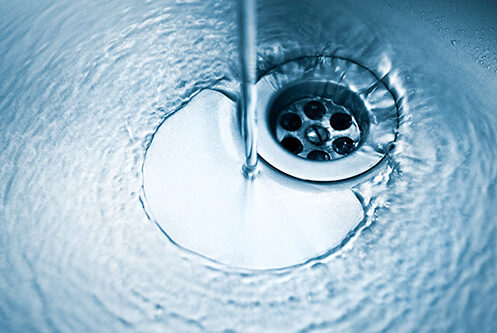Your plumbing system probably isn’t something you ever give that much thought to until an issue like a clog or leak arises. Indoor plumbing consists of different components located throughout various parts of the house. In this article, we’ll provide a detailed look at a plumbing system and the role each component plays.
Parts of a Plumbing System
All plumbing systems consist of two sides or subsystems. The first is the supply side, where clean water flows into your house and fixtures. The other is the discharge or drain/sewer side, which collects all of the wastewater and sewage and ensures it flows out of the house and into the municipal sewer system. All of your plumbing fixtures like your sinks, toilets and showers are essentially a bridge that connects the supply side to the drain side.
Understanding Your Supply Side Plumbing
The first part of the supply side is the main water line that connects the house to the municipal water system. This is typically either a 3/4- or 1-inch pipe buried far enough underground that it probably won’t freeze. Exactly how far the pipe is underground depends on where the frost line is in your location. The frost line in Arizona is only around 10-12 inches, but most water lines are still buried at least 2.5 feet below ground level just to be safe.
The main water line enters a house through the foundation. The water meter may be located where the line comes in. It may also be located at the street. The home’s main water shut-off valve is also typically located right where the main service line enters the house. There is also a second shut-off valve near where the home’s main service line connects to the municipal water main. This valve allows the water department to shut off the water to the home whenever needed, such as when doing work on the water system in the nearby area or if the underground service line to the home starts leaking.
Many homes then have a pressure-regulating valve next to the water meter just before your system connects to the main line. This valve is usually needed because the pressure in most municipal water systems is higher than an indoor plumbing system can handle.
You generally want your water pressure to be around 40 to 50 psi, and no higher than 60 psi. The water flowing from a municipal water main to a home is typically at least 80 psi and can be above 140 psi. The regulating valve works to slow down the flow of the water coming into a house to prevent the pressure from being so high that it could damage plumbing fixtures or cause pipes to develop a leak. The way that it works is that the valve has an internal diaphragm that can respond to changes in the pressure of the water coming into the house by expanding and contracting. This ensures that the water pressure remains constant.
Once the water line enters the house, it then connects to various supply lines that branch off to the bathroom, kitchen, laundry room, water heater and anywhere else you have plumbing fixtures. All of these pipes are your cold water supply lines, and you also have a series of hot water supply lines that branch off the outlet pipe on the water heater and lead to every fixture that has hot water. Except for your toilets and outdoor hose bibs, almost all of your plumbing fixtures have both a cold and hot water supply pipe. Hose bibs just have a single cold supply line, which connects to the hose bib stem at least a few inches inside the house. The stem sticks out of the foundation and connects to the hose valve and connection.
All of the main hot and cold supply lines are typically 3/4-inch copper or sometimes plastic PEX piping. The lines that supply your faucets and toilets stick a short way out through a wall near each fixture and have a shut-off valve at the end for when you need to work on the fixture. You then have a short piece of flexible 3/8- or 1/2-inch water line that screws onto the main supply line at one end and the faucet or toilet at the other.
An Overview of Your Home’s Drain Side Plumbing
The primary part of a home’s drain-side plumbing is the vertical plumbing stack, which consists of three separate parts. The uppermost section is the vent stack, which extends up through a wall into the attic and then sticks out at least two feet above the roof. The purpose of this vent is to allow air to get drawn into your drain system, which naturally happens every time you flush a toilet or run any water. Without the vent, your plumbing wouldn’t work properly. If air can’t get drawn in when using your plumbing, the water can form a vacuum that prevents it from draining away as it should.
The middle section is the drain stack. Each of the drainpipes leading from sinks, toilets, showers, etc. run down at an angle from the fixture and eventually connect to the vertical drain stack. In between each of the drainpipes and each shower, bathtub and sink is a short piece of pipe known as a P-trap. The bend in the trap is always full of water, and the water creates a barrier so that sewer gases get trapped and can’t rise out of the drain. Plumbing code requires all showers, sinks and bathtubs to have a P-trap. This is because sewer gas contains hydrogen sulfide and ammonia, which are toxic at high concentrations.
The lower section is the sewer stack, which sticks down through the foundation and connects to the underground sewer line. If your home was built in the past few decades, your sewer line is likely PVC or some other plastic pipe. This is also true for all other drain pipes inside your house. Older houses that still have the original plumbing may instead have cast iron pipes or sometimes even a clay sewer line.
If your sewer line is plastic, you most likely have one or two sewer cleanouts in your yard that connect to the sewer line underground. The purpose of a cleanout is to allow a plumber to easily access the sewer line when it needs to be cleaned, unclogged or inspected. If you don’t have a cleanout, it’s much more difficult to access the sewer line. In most cases, the only option is to either remove a toilet or go on the roof and access it through the vent and plumbing stack.
Are you searching for an honest, reliable and experienced plumbing, electrical or HVAC company in the Lake Havasu area? Air Control Home Services is a local, family-owned company that has been serving the area since 1990. We specialize in the full range of home services, including expert plumbing services, and our team will work to ensure all of your needs are expertly met. To request an appointment for any installation, repair or maintenance service for the plumbing in your home, whether for a water heater or your kitchen and bathroom plumbing, contact us today.






